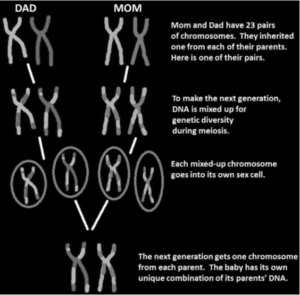Table of Contents
A brief outline
Sutton discovered that chromosomes are found in matched pairs of maternal and paternal chromosomes that separate during meiosis and “may form the physical basis of the Mendelian law of heredity” in grasshoppers. This pioneering work prompted E.B. Wilson to designate the chromosomal theory of heredity the “Sutton-Boveri Theory” in his classic text. Wilson had a strong relationship with both individuals, as Sutton was his pupil and Boveri was a buddy (in fact, Wilson dedicated the afore-mentioned book to Boveri). Despite the fact that the name order is now frequently reversed to “Boveri-Sutton,” some claim that Boveri didn’t properly describe the theory until 1904.
Cell biologists may use dyes to stain and detect subcellular structures and examine their actions throughout cell division and meiosis thanks to advancements in microscopic techniques in the late 1800s. Chromosomes are duplicated, condensed from an amorphous (non-uniform) nuclear mass into unique X-shaped entities (pairs of similar sister chromatids), and moved to separate cellular poles with each mitotic division.
Important concepts
- Chromosomal theory classification: Linkage and Genetic Recombination
Morgan saw that when a couple of elements were crossed, two qualities didn’t isolate as per Mendel’s regulation. Whenever two qualities were found on a similar chromosome, the probability of a parental blend on the cutting edge was considerably higher than that of a non-parental mix. Linkage alludes to the actual relationship of qualities. The non-parental strategies utilized in a dihybrid cross were alluded to as hereditary recombination. Following the revelation of connected qualities, the recurrence of associated qualities affected the indication of aggregates in resulting ages. Sturtevant, an understudy of Morgan’s, found the area of associated qualities on a chromosome by estimating their recurrence of hereditary recombination utilizing the quality planning strategy. This method for making an association map was generally utilized.
Chromosomal Theory of Inheritance Observations
Mendel’s rules are reinforced by the Chromosomal Model of Inheritance. The following are the results of this theory:
- The pairs of homologous chromosomes move as separate structures that are independent of other pairs of chromosomes during cell division-meiosis.
- Each homologous pair’s pre-gametes contain a random distribution of chromosomes.
- Each parent produces gametes, that account for half of their chromosome composition.
- Despite the fact that the size and shape of female (egg) and male (sperm) gametes differ, they both have the same number of chromosomes, submitting equivalent genetic contributions from each parent.
- During fertilization, the gametic chromosomes combine to produce offspring with the same number of chromosomes as their parents.
Chromosomes are an essential component of all living organisms because they contain the basic genetic or hereditary material known as genes, which provides genetic information to numerous cells. All living species rely on cellular activities for survival and effective functioning. Histones and proteins, which play an important role in metabolism and give protection from chemical enzymes, also cover the chemical composition of the chromosomes. This makes it possible for the DNA to function normally during cell division. Non-histone proteins found in chromosomes also have a role in gene regulation.

Factors Affecting Mendel’s Theory Recognition
- His work was primarily hidden from society due to a lack of easy public communication.
- His Inheritance Theory was not extensively popularised, limiting the number of people who heard about it.
- At the time, Mendel’s hypothesis of genes regulating character was not well received by his peers.
- To explain biological phenomena, Mendel employed mathematical principles. This was a once-in-a-lifetime application that multiple biologists deemed unsuitable and rejected.
- Despite the fact that Mendel proposed genes as discrete and stable entities, he was unable to provide physical evidence for their existence.
Significance of chromosome theory of inheritance in NEET exam
Each year, around 50 questions based on inheritance and variation concepts will be asked. Every year, approximately 5% of queries were devoted to the chromosomal hypothesis of inheritance. In past years, this topic was 70% easy, and almost every student was able to accurately answer all of the questions. There are no parts of this unit that have been removed.
FAQs
Carl Wilhelm von Nageli, a Swiss botanist, was quick to distinguish chromosomes and explore cell divisions.
It is a fundamental guideline of hereditary qualities that recognizes chromosomes as carriers of hereditary data is the legacy hypothesis.
The Chromosomal Theory of Inheritance is said to have been created by two researchers, Theodor Boveri and Walter Sutton.
The expression transformation alludes to a change or super durable modification in the nucleotide grouping of a creature's genome. Who was quick to find chromosomes?
What is the legacy hypothesis in view of chromosomes?
Who was the individual who originally introduced the chromosomal hypothesis of legacy?
What is the meaning of transformations?









